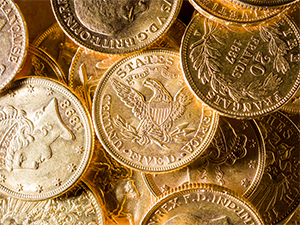 Gold prices finished below $1,300 an ounce on Tuesday, hitting a final price of $1,295.20. Positive economic news, including better-than-expected U.S. housing data, and rally of the U.S. dollar index to an 11-month high, drove investors back to the stock market. There are still a number of conflicts worldwide that are keeping investors in gold as a safe-haven vehicle, but there is no question that the risk appetite is increasing.
Gold prices finished below $1,300 an ounce on Tuesday, hitting a final price of $1,295.20. Positive economic news, including better-than-expected U.S. housing data, and rally of the U.S. dollar index to an 11-month high, drove investors back to the stock market. There are still a number of conflicts worldwide that are keeping investors in gold as a safe-haven vehicle, but there is no question that the risk appetite is increasing.
Investors are also eagerly awaiting this Thursday’s annual Kansas City Federal Reserve meeting in Jackson Hole, Wyoming. In prior years, a number of clues to the future of U.S. monetary policy have come from this meeting. Fed Chair Janet Yellen and ECB (European Central Bank) President Mario Draghi are scheduled to speak at the meeting on Friday. Even before the meeting begins, comes the Federal Reserve’s FOMC minutes on Wednesday afternoon. Although it is expected that no major changes will be announced, the minutes should be closely scrutinized.
Despite all of the positive economic data, Kitco News is reporting that due to subdued consumer inflation data, sluggish wage growth, and falling commodity prices, there are still a number of market analysts concerned about deflation. Rob Haworth, senior investment strategist at U.S. Bank Wealth Management, does not believe the usual indicators are signaling further price drops, however.
Haworth told Kitco News, “We’re not expecting a deflationary scenario in the U.S. at all at this point. If we’re wrong, we’d have to be wrong about the state of the global economy and see more declines in commodities in general. For the U.S. in particular, the health in the employment sector means we’re not particularly worried. There are problems elsewhere and the decline in food prices is certainly having an impact on, say inflation in the Eurozone, and that’s going to make the ECB’s job harder. (But) the Russian/Ukraine issue may work itself out later this year anyway. They might not have a deflation problem as they get into winter at all.”
Haworth went on to tell Kitco that U.S. Bank sees the U.S. economy growing, which makes them bearish on gold.
“With our thesis of an improving global economy, that also means the end of the Fed’s quantitative easing program, (and they will) probably raise interest rates at some point. This is all negative for gold, including better economic growth…I say that, and what, gold is up 7% this year? It’s not as strong as it was, and it’s clearly not in a new bull market phase, but it clearly has support,” he said.
So once again all eyes will be on the Federal Reserve this week, looking for any clues as to where the U.S. monetary policy may be headed. Expect any announcement to have an immediate effect on gold prices. In addition, any changes in the geopolitical climate will play a large part in where gold is headed in the short term.
